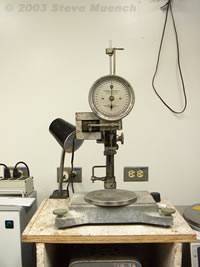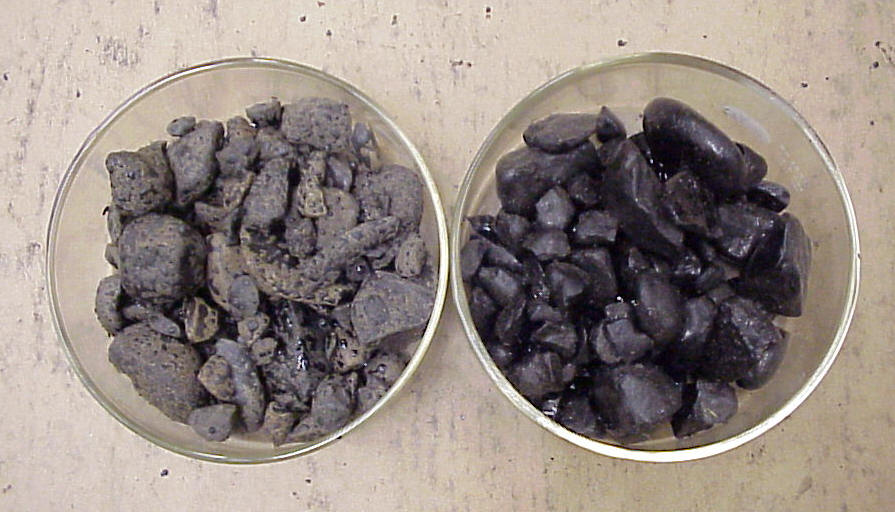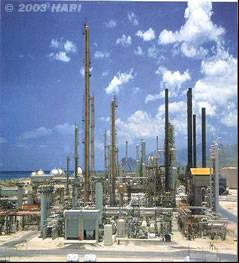Asphalt is a dark brown to black, highly viscous, hydrocarbon produced from petroleum distillation residue. This distillation can occur naturally, resulting in asphalt lakes, or occur in a petroleum refinery using crude oil. In 2020, the U.S. produced about 21 million tons of asphalt (US EIA). Roads and highways constitute the largest single use of asphalt at about 80 percent of the total (Fredonia Group). In HMA, asphalt functions as a waterproof, thermoplastic, viscoelastic adhesive. By weight, asphalt generally accounts for between 4 and 8 percent of HMA and makes up about 25 – 30 percent of the cost of an HMA pavement structure depending upon the type and quantity. The paving industry also uses asphalt emulsions, asphalt cutbacks and foamed asphalt.
“Asphalt cement” refers to asphalt that has been prepared for use in HMA and other paving applications. This section uses the generic term, “asphalt binder”, to represent the principal binding agent in HMA because “asphalt binder” includes asphalt cement as well as any material added to modify the original asphalt cement properties.
Asphalt Physical Properties
Asphalt can be classified by its chemical composition and physical properties. The pavement industry typically relies on physical properties for performance characterization although an asphalt’s physical properties are a direct result of its chemical composition. Typically, the most important physical properties are:
- Durability. Durability is a measure of how asphalt binder physical properties change with age (sometimes called age hardening). In general, as an asphalt binder ages, its viscosity increases and it becomes more stiff and brittle.
- Rheology. Rheology is the study of deformation and flow of matter. Deformation and flow of the asphalt binder in HMA is important in HMA pavement performance. HMA pavements that deform and flow too much may be susceptible to rutting and bleeding, while those that are too stiff may be susceptible to fatigue cracking. HMA pavement deformation is closely related to asphalt binder rheology. Rheological properties of asphalt binder vary with temperature, so rheological characterization involves two key considerations. First, to fully characterize an asphalt binder, its rheological properties must be examined over the range of temperatures that it may encounter during its life. Secondly, to compare different asphalt binders, their rheological properties must be measured at some common reference temperature.
- Safety. Asphalt cement like most other materials, volatilizes (gives off vapor) when heated. At extremely high temperatures (well above those experienced in the manufacture and construction of HMA) asphalt cement can release enough vapor to increase the volatile concentration immediately above the asphalt cement to a point where it will ignite (flash) when exposed to a spark or open flame. This is called the flash point. For safety reasons, the flash point of asphalt cement is tested and controlled.
- Purity. Asphalt cement, as used in HMA paving, should consist of almost pure bitumen. Impurities are not active cementing constituents and may be detrimental to asphalt performance.
Grading Systems
Asphalt binders are typically categorized by one or more shorthand grading systems according to their physical characteristics. These systems range from simple to complex and represent an evolution in the ability to characterize asphalt binder. Today, most state agencies use or are planning to switch to the Superpave performance grading (PG) system.

Penetration Grading
Based on the depth a standard needle will penetrate an asphalt binder sample when placed under a 100 g load for 5 seconds (see Figure 3). The test is simple and easy to perform but it does not measure any fundamental parameter and can only characterize asphalt binder at one temperature (77°F). Penetration grades are listed as a range of penetration units (one penetration unit = 0.1 mm of penetration by the standard needle). Typical asphalt binders used in the U.S. are 65-70 pen and 85-100 pen.
Viscosity Grading
Measures penetration (as in penetration grading) but also measures an asphalt binder’s viscosity at 140°F and 275°F. Testing can be done on virgin (AC) or aged (AR) asphalt binder. Grades are listed in poises (cm-g-s = dyne-second/cm2) or poises divided by 10. Typical asphalt binders used in the U.S. are AC-10, AC-20, AC-30, AR-4000 and AR-8000. Viscosity grading is a better grading system but it does not test low temperature asphalt binder rheology.
Superpave Performance Grading (PG) System
The Superpave PG system was developed as part of the Superpave research effort to more accurately and fully characterize asphalt binders for use in HMA pavements. The PG system is based on the idea that an HMA asphalt binder’s properties should be related to the conditions under which it is used. For asphalt binders, this involves expected climatic conditions as well as aging considerations. Therefore, the PG system uses a common battery of tests (as the older penetration and viscosity grading systems do) but specifies that a particular asphalt binder must pass these tests at specific temperatures that are dependent upon the specific climatic conditions in the area of intended use. Therefore, a binder used in Hawai’i would be different than one used in, say, Alaska.
Superpave performance grading is reported using two numbers – the first being the average seven-day maximum pavement temperature (in °C) and the second being the minimum pavement design temperature likely to be experienced (in °C). Thus, a PG 64-16 is intended for use where the average seven-day maximum pavement temperature is 64°C and the expected minimum pavement temperature is -16°C. Notice that these numbers are pavement temperatures and not air temperatures. The typical PG grade used in Hawai’i is a PG 64-16. Realistically, pavement temperatures in Hawai’i will never dip down to -16°C, but the typical asphalt binder used will meet this standard so it is graded as such.
Asphalt Binder Modifiers
Some asphalt cements require modification in order to meet specifications. Asphalt cement modification has been practiced for over 50 years but has received added attention in the past decade or so. There are numerous binder additives available on the market today. The benefits of modified asphalt cement can only be realized by a judicious selection of the modifier(s); not all modifiers are appropriate for all applications. In general, asphalt cement should be modified to achieve the following types of improvements (Roberts et al., 1996[2]):
- Lower stiffness (or viscosity) at the high temperatures associated with construction. This facilitates pumping of the liquid asphalt binder as well as mixing and compaction of HMA.
- Higher stiffness at high service temperatures. This will reduce rutting and shoving.
- Lower stiffness and faster relaxation properties at low service temperatures. This will reduce thermal cracking.
- Increased adhesion between the asphalt binder and the aggregate in the presence of moisture. This will reduce the likelihood of stripping. Figure 4 shows two aggregate samples from the same source after they have been coated with asphalt binder. The asphalt binder used with the sample on the left contain no anti-stripping modifier, which resulted in almost no aggregate-asphalt binder adhesion. The asphalt binder used with the sample on the right contains 0.5% (by weight of asphalt binder) of an anti-stripping modifier, which results in good aggregate-asphalt binder adhesion.

Other Forms of Asphalt Used in Paving
Besides asphalt cement, three other forms of asphalt are used prominently in the paving industry:
- Emulsified asphalt. Emulsified asphalt is a suspension of small asphalt cement globules in water, which is assisted by an emulsifying agent (such as soap). Emulsions have lower viscosities than neat (plain) asphalt and can thus be used in low temperature applications. After an emulsion is applied the water evaporates away and only the asphalt cement is left. Emulsions are often used as prime coats and tack coats.
- Cutback asphalt. A cutback asphalt is a combination of asphalt cement and petroleum solvent. Like emulsions, cutbacks are used because their viscosity is lower than that of neat asphalt and can thus be used in low temperature applications. After a cutback is applied the solvent evaporates away and only the asphalt cement is left. Cutbacks are much less common today because the petroleum solvent is more expensive than water and can be an environmental concern. Cutbacks are typically used as prime coats and tack coats.
- Foamed asphalt. Foamed asphalt is formed by combining hot asphalt binder with small amounts of cold water. When the cold water comes in contact with the hot asphalt binder it turns to steam, which becomes trapped in tiny asphalt binder bubbles (World Highways, 2001[3]). The result is a thin-film, high volume asphalt foam. This high volume foam state only lasts for a few minutes, after which the asphalt binder resumes its original properties. Foamed asphalt can be used as a binder in soil or base course stabilization, and is often used as the stabilizing agent in cold in-place recycling (CIPR).
[[1]]Asphalt Institute. (2001). HMA Construction. Manual Series No. 22 (MS-22). Asphalt Institute. Lexington, KY.[[1]]


